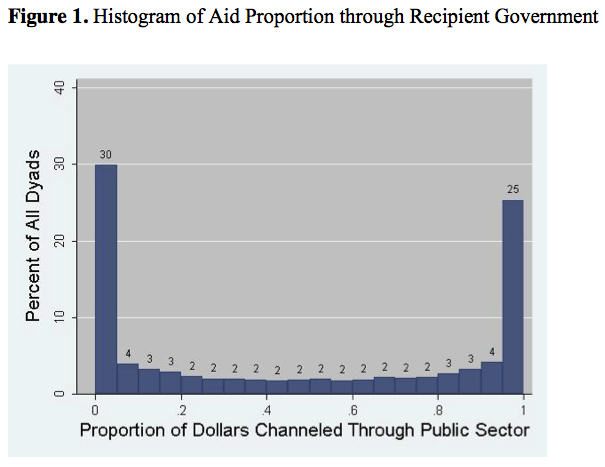Nicholas Jones and Dr. Darren Hawkins, Department of Political Science
Our research examines whether donor countries care about the quality of nongovernmental organizations (NGOs) when giving foreign aid to poor countries. When donor states give foreign aid to recipient states, such the US giving foreign aid to Uganda, the donor states must choose what is called a channel of delivery. This is the channel through which the donor’s aid will reach the intended beneficiaries. Donors can opt to channel their aid directly through the recipient government, or they can bypass the recipient government and instead utilize a non-state channel, such as an NGO. In past times, many donors have chanelled their aid through the recipient government, either because the aid’s purpose was to strengthen the government itself, or because of its distributional power.
Many donors, though, have become frustrated of late with corruption in recipient governments, which results in either their aid money being mismanaged, or perhaps even stolen. Because of this, donor states have increasingly circumvented recipient governments and instead utilized non-state channels, such as NGOs in their aid allocation decisions. Donors states often see NGOs as an appealing alternative to governments (their very name reflects this; they are defined by what they are not), because they ostensibly are free from much of the corruption that plagues governments in developing countries. Thus, NGOs perhaps present an avenue where donor’s aid
is more likely to be well used. However, partially in response to this, some recipient governments see NGOs as a threat and as such, impose crippling regulations on them or force their dissolution under the pretense of sedition. Since not all countries have NGOs with equal capacity to carry out aid projects, donors should take this into consideration when making decisions about how to channel their aid, so that it can be most effectively used to alleviate suffering and stimulate economic growth.
In our research we define NGO capacity as the ability of NGOs to formulate and implement their missions. We quantify this variable and use it in our model of donor’s channel of delivery decisions. We hypothesize that donors will channel choose non-state channels in poorly-governed recipients, and that they will choose NGOs more often in recipients with high NGO Capacity.
To quantify NGO capacity, we use the NGO Sustainability Index (NGOSI) published by the United States Agency for International Development (USAID). The index contains factors such as the legal environment NGOs face, the sustainability of their funding, and the extent to which the public trusts them in that country. The NGOSI is published for the years 1998-2009 for the Eastern Europe/Eurasia region, and in 2009 only for the Africa region. While there are seven different categories contained within the NGOSI, due to large colinearity between them, we use only the Overall Score in our model.
To quantify recipient governance, we use the Government Effectiveness indicator from the World Governance Indicators, published annually by the World Bank. We also include other control variables such as recipient income, whether the recipient was a former colony of a donor, whether there was a civil war in the recipient, etc.
In order to operationalize the channel of delivery that donors choose, we create a binary variable called bypass. The variable is coded as a 1 if a donor channeled less than 0.5% of their aid through the recipient government in that year, and 0 as otherwise. Operationalizing channel of delivery in this way allows for donors to still fund token projects through the recipient government, so as not to incur their complete anger, while still effectively bypassing them. It makes sense to operationalize this variable as a binary one, because donors channel their aid in a very bi-modal manner, usually opting to channel all of their aid through the recipient government, or none at all (See Figure 1).
We find little evidence that donors take NGO capacity into account when making aid allocation and channel of delivery decisions. In Eastern Europe and Eurasia, NGO capacity has no statistically significant effect on whether donors bypass the recipient government or not. In Africa, surprisingly, donors utilize NGOs significantly more often in the recipients that have the lowest NGO capacity, and utilize NGOs significantly less often in the recipients with the worst NGO capacity. At first we thought that his was because well-governed countries will likely have higher-capacity NGOs, in which case the donor state would simply opt to utilize the well-governed country. However, these results stand even after controlling for governance, so the capacity of the recipient state is not driving them. It appears that donors are either not cognizant of NGO capacity, or that it is proxying for some other unobserved variable which influences channel of delivery decisions on the part of donors.

